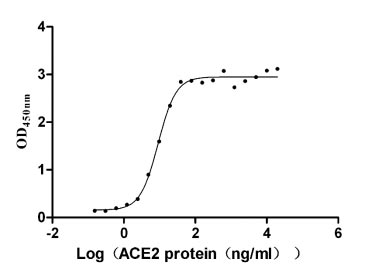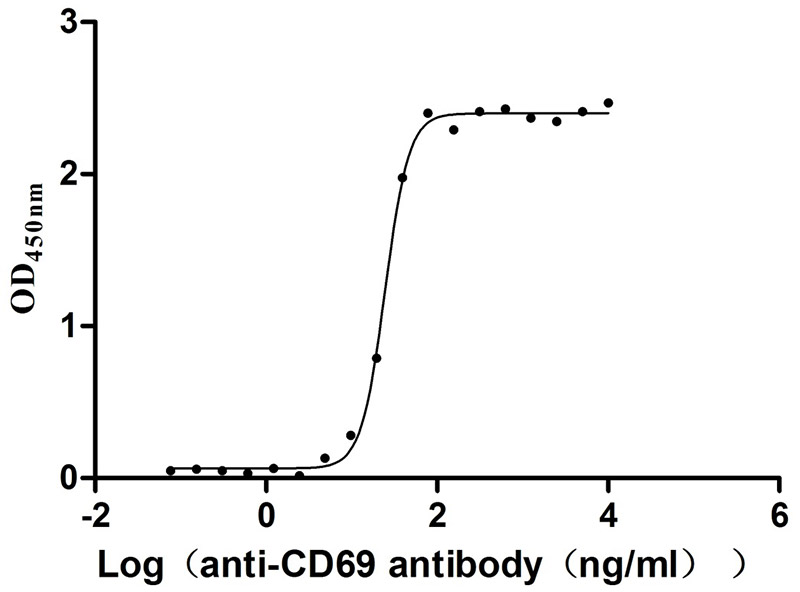Recombinant Human Free fatty acid receptor 3 (FFAR3), partial
-
货号:CSB-YP008606HU1
-
规格:
-
来源:Yeast
-
其他:
-
货号:CSB-EP008606HU1-B
-
规格:
-
来源:E.coli
-
共轭:Avi-tag Biotinylated
E. coli biotin ligase (BirA) is highly specific in covalently attaching biotin to the 15 amino acid AviTag peptide. This recombinant protein was biotinylated in vivo by AviTag-BirA technology, which method is BriA catalyzes amide linkage between the biotin and the specific lysine of the AviTag.
-
其他:
-
货号:CSB-BP008606HU1
-
规格:
-
来源:Baculovirus
-
其他:
-
货号:CSB-MP008606HU1
-
规格:
-
来源:Mammalian cell
-
其他:
产品详情
-
纯度:>85% (SDS-PAGE)
-
基因名:
-
Uniprot No.:
-
别名:FFAR3; GPR41; Free fatty acid receptor 3; G-protein coupled receptor 41
-
种属:Homo sapiens (Human)
-
蛋白长度:Partial
-
蛋白标签:Tag type will be determined during the manufacturing process.
The tag type will be determined during production process. If you have specified tag type, please tell us and we will develop the specified tag preferentially. -
产品提供形式:Lyophilized powder
Note: We will preferentially ship the format that we have in stock, however, if you have any special requirement for the format, please remark your requirement when placing the order, we will prepare according to your demand. -
复溶:We recommend that this vial be briefly centrifuged prior to opening to bring the contents to the bottom. Please reconstitute protein in deionized sterile water to a concentration of 0.1-1.0 mg/mL.We recommend to add 5-50% of glycerol (final concentration) and aliquot for long-term storage at -20℃/-80℃. Our default final concentration of glycerol is 50%. Customers could use it as reference.
-
储存条件:Store at -20°C/-80°C upon receipt, aliquoting is necessary for mutiple use. Avoid repeated freeze-thaw cycles.
-
保质期:The shelf life is related to many factors, storage state, buffer ingredients, storage temperature and the stability of the protein itself.
Generally, the shelf life of liquid form is 6 months at -20°C/-80°C. The shelf life of lyophilized form is 12 months at -20°C/-80°C. -
货期:Delivery time may differ from different purchasing way or location, please kindly consult your local distributors for specific delivery time.Note: All of our proteins are default shipped with normal blue ice packs, if you request to ship with dry ice, please communicate with us in advance and extra fees will be charged.
-
注意事项:Repeated freezing and thawing is not recommended. Store working aliquots at 4°C for up to one week.
-
Datasheet :Please contact us to get it.
相关产品
靶点详情
-
功能:G protein-coupled receptor that is activated by a major product of dietary fiber digestion, the short chain fatty acids (SCFAs), and that plays a role in the regulation of whole-body energy homeostasis and in intestinal immunity. In omnivorous mammals, the short chain fatty acids acetate, propionate and butyrate are produced primarily by the gut microbiome that metabolizes dietary fibers. SCFAs serve as a source of energy but also act as signaling molecules. That G protein-coupled receptor is probably coupled to the pertussis toxin-sensitive, G(i/o)-alpha family of G proteins. Its activation results in the formation of inositol 1,4,5-trisphosphate, the mobilization of intracellular calcium, the phosphorylation of the MAPK3/ERK1 and MAPK1/ERK2 kinases and the inhibition of intracellular cAMP accumulation. Activated by SCFAs and by beta-hydroxybutyrate, a ketone body produced by the liver upon starvation, it inhibits N-type calcium channels and modulates the activity of sympathetic neurons through a signaling cascade involving the beta and gamma subunits of its coupled G protein, phospholipase C and MAP kinases. Thereby, it may regulate energy expenditure through the control of the sympathetic nervous system that controls for instance heart rate. Upon activation by SCFAs accumulating in the intestine, it may also signal to the brain via neural circuits which in turn would regulate intestinal gluconeogenesis. May also control the production of hormones involved in whole-body energy homeostasis. May for instance, regulate blood pressure through renin secretion. May also regulate secretion of the PYY peptide by enteroendocrine cells and control gut motility, intestinal transit rate, and the harvesting of energy from SCFAs produced by gut microbiota. May also indirectly regulate the production of LEP/Leptin, a hormone acting on the CNS to inhibit food intake, in response to the presence of short-chain fatty acids in the intestine. Finally, may also play a role in glucose homeostasis. Besides its role in energy homeostasis, may play a role in intestinal immunity. May mediate the activation of the inflammatory and immune response by SCFAs in the gut, regulating the rapid production of chemokines and cytokines by intestinal epithelial cells. Among SCFAs, the fatty acids containing less than 6 carbons, the most potent activators are probably propionate, butyrate and pentanoate while acetate is a poor activator.
-
基因功能参考文献:
- FFAR2 and FFAR3 interact to form a heteromer in primary monocytes and macrophages via proximity ligation assay, and during heterologous expression in HEK293 cells via bimolecular fluorescence complementation and fluorescence resonance energy transfer. FFAR2 and FFAR3 may interact to form a receptor heteromer with signaling that is distinct from the parent homomers. PMID: 28883043
- Data suggest that cytokines TNFalpha and interleukin-1b markedly reduce GPR120/FFAR4 expression in adipocytes; in contrast, these cytokines induce expression of GPR84 and GPR41/FFAR3 in adipocytes. These studies were conducted in adipocytes cultured from subcutaneous adipose tissue. (GPR = G-protein coupled receptor; FFAR = free fatty acid receptor) PMID: 28835131
- a single dose of soluble fibre was able to significantly reduce airway inflammation in stable asthma by downregulating GPR43 and GPR41 PMID: 28075383
- Short-chain fatty acids lowered TNF-alpha-induced MCP-1 expression by reducing phosphorylation of p38 MAPK and JNK in a GPR41/GRP43-dependent manner in renal cortical epithelial cells. PMID: 28322790
- Our data suggest that GPR42 be reclassified as a functioning gene and that recognition of sequence and copy number polymorphism of the FFAR3/GPR42 complex be considered during genetic and pharmacological investigation of these receptors. PMID: 26260360
- FFAR3 is expressed in pancreatic beta cells and mediates an inhibition of insulin secretion by coupling to Gi-type G proteins. PMID: 25581519
- a significant correlation between a higher body mass index and lower methylation in the promoter region of FFAR3 in type 2 diabetes and obesity patients PMID: 24325907
- Extracellular ionic locks determine variation in constitutive activity and ligand potency between species orthologs of the free fatty acid receptors FFA2 and FFA3 PMID: 23066016
- GPR41 activation inhibits histone acetylation and cell growth. PMID: 22884094
- Selective orthosteric free fatty acid receptor 2 (FFA2) agonists: identification of the structural and chemical requirements for selective activation of FFA2 versus FFA3. PMID: 21220428
- characterization of GP41 in human tissue as a receptor for short chain fatty acids PMID: 12711604
- C2-C6 short-chain fatty acids, ligands of an orphan G protein-coupled receptor GPR41, stimulate leptin expression in both a mouse adipocyte cell line and mouse adipose tissue in primary culture PMID: 14722361
- GPR41 and 43 mediate SCFA signaling in mammary epithelial cells and thereby play an important role in their stress management. PMID: 16887331
- analysis of conserved polar residues in transmembrane domains V, VI, and VII of free fatty acid receptor 2 and free fatty acid receptor 3 are required for the binding and function of short chain fatty acids PMID: 18801738
- Results suggest that GPR41 expressed in human colonic mucosa may function as a sensor for luminal short-chain fatty acids. PMID: 19574715
- Study presents evidence showing that the six amino acid differences, including that R/W174 are polymorphisms rather than gene-specific differences between GPR41 and GPR42. PMID: 19630535
显示更多
收起更多
-
亚细胞定位:Cell membrane; Multi-pass membrane protein.
-
蛋白家族:G-protein coupled receptor 1 family
-
组织特异性:Highest level in adipose tissue, and lower expression across all tissues tested. Expressed in sympathetic ganglia.
-
数据库链接:
HGNC: 4499
OMIM: 603821
KEGG: hsa:2865
STRING: 9606.ENSP00000328230
UniGene: Hs.248055
Most popular with customers
-
Recombinant Human SARS coronavirus Spike glycoprotein (S), partial (Active)
Express system: Mammalian cell
Species: Human SARS coronavirus (SARS-CoV) (Severe acute respiratory syndrome coronavirus)
-
Express system: Mammalian cell
Species: Homo sapiens (Human)
-
Recombinant Human Carcinoembryonic antigen-related cell adhesion molecule 6 (CEACAM6) (Active)
Express system: Mammalian cell
Species: Homo sapiens (Human)
-
Recombinant Human Claudin-3 (CLDN3)-VLPs (Active)
Express system: Mammalian cell
Species: Homo sapiens (Human)
-
Recombinant Human Early activation antigen CD69 (CD69), partial (Active)
Express system: Mammalian cell
Species: Homo sapiens (Human)
-
Recombinant Human CUB domain-containing protein 1 (CDCP1), partial (Active)
Express system: Mammalian cell
Species: Homo sapiens (Human)
-
Recombinant Human Myosin regulatory light chain 12B(MYL12B) (Active)
Express system: E.coli
Species: Homo sapiens (Human)
-
Recombinant Human Myosin regulatory light chain 12A (MYL12A) (Active)
Express system: E.coli
Species: Homo sapiens (Human)




















